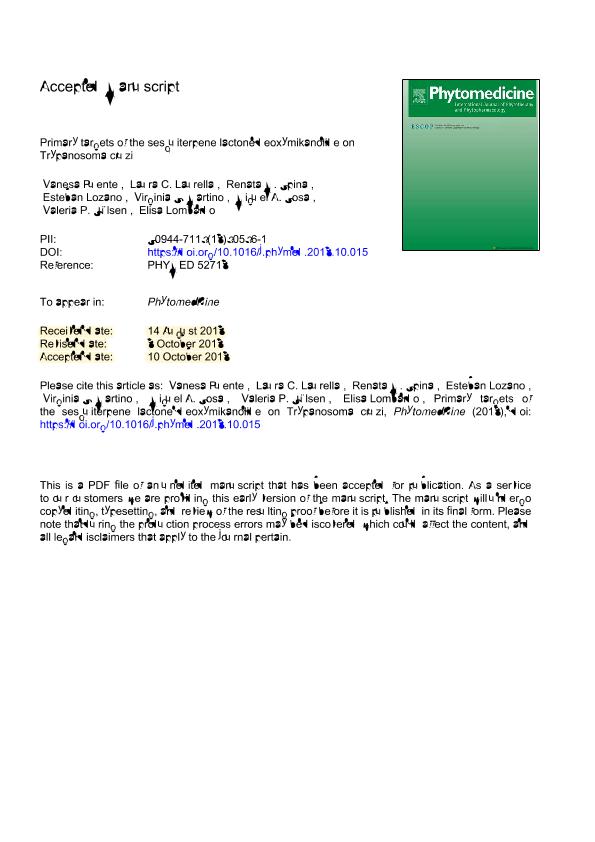Artículo
Primary targets of the sesquiterpene lactone deoxymikanolide on Trypanosoma cruzi
Puente, Vanesa Rocío ; Laurella, Laura Cecilia; Spina Zapata, Renata María
; Laurella, Laura Cecilia; Spina Zapata, Renata María ; Lozano, Esteban Sebastián
; Lozano, Esteban Sebastián ; Martino, Virginia Susana
; Martino, Virginia Susana ; Sosa Escudero, Miguel Angel
; Sosa Escudero, Miguel Angel ; Sülsen, Valeria Patricia
; Sülsen, Valeria Patricia ; Lombardo, Maria Elisa
; Lombardo, Maria Elisa
 ; Laurella, Laura Cecilia; Spina Zapata, Renata María
; Laurella, Laura Cecilia; Spina Zapata, Renata María ; Lozano, Esteban Sebastián
; Lozano, Esteban Sebastián ; Martino, Virginia Susana
; Martino, Virginia Susana ; Sosa Escudero, Miguel Angel
; Sosa Escudero, Miguel Angel ; Sülsen, Valeria Patricia
; Sülsen, Valeria Patricia ; Lombardo, Maria Elisa
; Lombardo, Maria Elisa
Fecha de publicación:
03/2019
Editorial:
Elsevier Gmbh
Revista:
Phytomedicine
ISSN:
0944-7113
Idioma:
Inglés
Tipo de recurso:
Artículo publicado
Clasificación temática:
Resumen
Background: Deoxymikanolide is a sesquiterpene lactone isolated from Mikania micrantha and M. variifolia which, has previously demonstrated in vitro activity on Trypanosoma cruzi and in vivo activity on an infected mouse model. Purpose: Based on these promising findings, the aim of this study was to investigate the mechanism of action of this compound on different parasite targets. Methods: The interaction of deoxymikanolide with hemin was examined under reducing and non- reducing conditions by measuring modifications in the Soret absorption band of hemin; the thiol interaction was determined spectrophotometrically through its reaction with 5,5′-dithiobis-2-nitrobenzoate in the presence of glutathione; activity on the parasite antioxidant system was evaluated by measuring the activity of the superoxide dismutase and trypanothione reductase enzymes, together with the intracellular oxidative state by flow cytometry. Superoxide dismutase and trypanothione reductase activities were spectrophotometrically tested. Cell viability, phosphatidylserine exposure and mitochondrial membrane potential were assessed by means of propidium iodide, annexin-V and rhodamine 123 staining, respectively; sterols were qualitatively and quantitatively tested by TLC; ultrastructural changes were analyzed by transmission electron microscopy. Autophagic cells were detected by staining with monodansylcadaverine. Results: Deoxymikanolide decreased the number of reduced thiol groups within the parasites, which led to their subsequent vulnerability to oxidative stress. Treatment of the parasites with the compound produced a depolarization of the mitochondrial membrane even though the plasma membrane permeabilization was not affected. Deoxymikanolide did not affect the intracellular redox state and so the mitochondrial dysfunction produced by this compound could not be attributed to ROS generation. The antioxidant defense system was affected by deoxymikanolide at twenty four hours of treatment, when both an increased oxidative stress and decreased activity of superoxide dismutase and trypanothione reductase (40 and 60% respectively) were observed. Both the oxidative stress and mitochondrial dysfunction induce parasite death by apoptosis and autophagy. Conclusion: Based on our results, deoxymikanolide would exert its anti-T cruzi activity as a strong thiol blocking agent and by producing mitochondrial dysfunction.
Palabras clave:
DCF: DICHLOROFLUORESCEIN
,
DCIP: 2,6-DICHLOROPHENOLINDOPHENOL
,
DEOXYMIKANOLIDE
,
DMSO: DIMETHYL SULFOXIDE
,
DTNB: 5,5′-DITHIOBIS-2-NITROBENZOATE
,
GSH: GLUTATHIONE
,
H2DCFDA: 2′,7′-DICHLORODIHYDROFLUORESCEIN DIACETATE
,
MITOCHONDRIAL DYSFUNCTION
,
OXIDATIVE STRESS
,
PBS: PHOSPHATE BUFFERED SALINE
,
PI: PROPIDIUM IODIDE
,
RH123: RHODAMINE 123
,
ROS: REACTIVE OXYGEN SPECIES
,
SCR: SUCCINATE CYTOCHROME C REDUCTASE
,
SESQUITERPENE LACTONE
,
SOD: SUPEROXIDE DISMUTASE
,
TRYPANOSOMA CRUZI
,
TRYR: TRYPANOTHIONE REDUCTASE
,
ULTRAESTRUCTURAL DAMAGE
Archivos asociados
Licencia
Identificadores
Colecciones
Articulos(CIPYP)
Articulos de CENTRO DE INVEST. SOBRE PORFIRINAS Y PORFIRIAS
Articulos de CENTRO DE INVEST. SOBRE PORFIRINAS Y PORFIRIAS
Articulos(IHEM)
Articulos de INST. HISTOLOGIA Y EMBRIOLOGIA DE MEND DR.M.BURGOS
Articulos de INST. HISTOLOGIA Y EMBRIOLOGIA DE MEND DR.M.BURGOS
Articulos(IMBECU)
Articulos de INST. DE MEDICINA Y BIO. EXP. DE CUYO
Articulos de INST. DE MEDICINA Y BIO. EXP. DE CUYO
Articulos(IQUIMEFA)
Articulos de INST.QUIMICA Y METABOLISMO DEL FARMACO (I)
Articulos de INST.QUIMICA Y METABOLISMO DEL FARMACO (I)
Citación
Puente, Vanesa Rocío; Laurella, Laura Cecilia; Spina Zapata, Renata María; Lozano, Esteban Sebastián; Martino, Virginia Susana; et al.; Primary targets of the sesquiterpene lactone deoxymikanolide on Trypanosoma cruzi; Elsevier Gmbh; Phytomedicine; 56; 3-2019; 27-34
Compartir
Altmétricas



